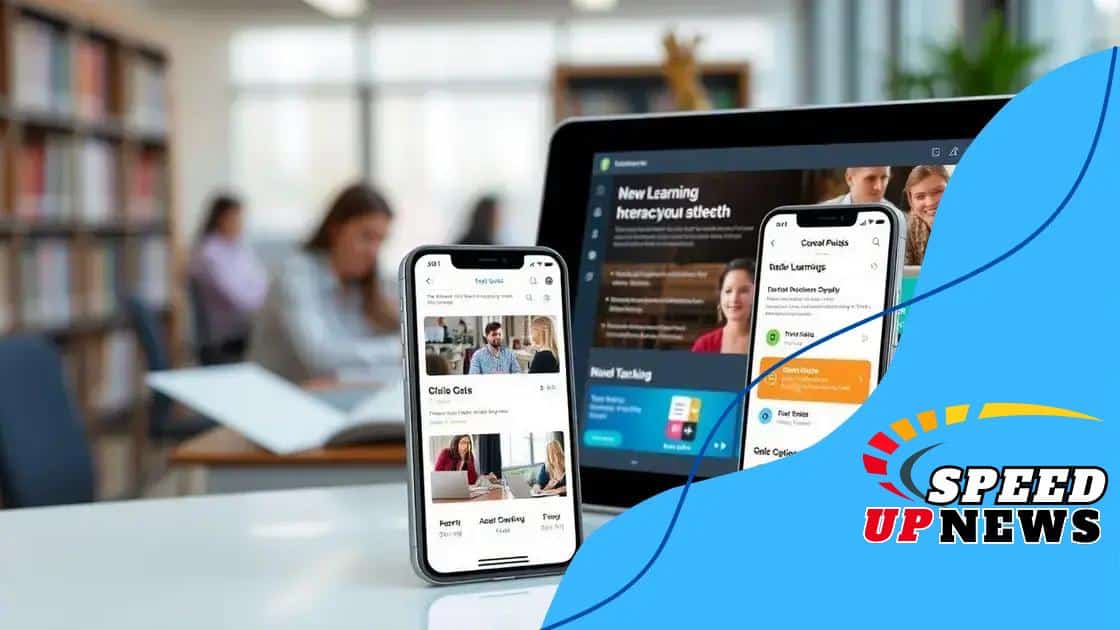Mobile learning platforms for higher education: unlock potential

Mobile learning platforms for higher education provide flexible, accessible, and personalized learning experiences, utilizing technologies like augmented reality and gamification to enhance student engagement and overcome traditional educational challenges.
In today’s fast-paced world, mobile learning platforms for higher education are transforming how students access knowledge. Imagine being able to learn anytime, anywhere, right from your device. This article explores the features, benefits, and challenges of these innovative platforms.
What are mobile learning platforms?
Mobile learning platforms are digital tools that enable students to access educational content via their mobile devices. These platforms are designed to make learning more accessible and flexible for higher education students.
Key Characteristics of Mobile Learning Platforms
These platforms often come with several features that enhance the learning experience. They include:
- Interactive Content: Engaging videos, quizzes, and discussion forums promote active learning.
- Accessibility: Students can access materials anytime, anywhere, making it easier to balance studies with personal commitments.
- User-Friendly Interfaces: Intuitive designs ensure that even those less tech-savvy can navigate the platform effortlessly.
- Real-Time Feedback: Instant assessments and feedback help students gauge their understanding and progress.
The success of mobile learning platforms can be attributed to how well they align with modern students’ lifestyles. Today’s learners often juggle multiple responsibilities, making flexibility a priority. Because of this, these platforms have gained significant popularity.
In addition to accessibility, mobile learning platforms promote collaboration. Students can connect with peers and instructors through messaging systems and forums. This creates a sense of community even when individuals are miles apart.
Moreover, the ability to track progress is a vital feature of these platforms. With analytics and insights, students can see how they are performing and where they may need improvement. This personalized focus helps keep them motivated.
Benefits of mobile learning for students
The benefits of mobile learning for students are numerous and significant. Many learners today prefer to engage with course materials through their mobile devices, which allows for a more tailored educational experience.
Advantages of Mobile Learning
One of the primary advantages is flexibility. Students can study and access course materials whenever they want, whether they’re commuting or at home. This ability to learn on-the-go helps in managing their time effectively.
- Personalized Learning: Mobile learning allows students to learn at their own pace, making it easier to grasp difficult concepts.
- Increased Engagement: Interactive content, such as videos and quizzes, keeps students motivated to learn.
- Cost-Effective: Many mobile learning platforms provide free or lower-cost resources, making education accessible.
- Global Learning Opportunities: Students can connect with peers and instructors worldwide, broadening their perspectives.
In addition to these advantages, mobile learning fosters collaboration. Students can easily share ideas and resources, facilitating a community of learning. Communication tools within these platforms further enhance group projects and discussions.
Another remarkable benefit is access to a wealth of information. Libraries, textbooks, and research materials are often just a click away. This abundance of resources empowers students to deepen their understanding and complete assignments efficiently.
Moreover, adaptive learning technologies in mobile platforms offer personalized recommendations based on each student’s strengths and weaknesses. This tailored approach can significantly enhance educational outcomes.
Key features of effective mobile learning platforms

Effective mobile learning platforms possess several key features that enhance the learning experience for students. These features not only improve accessibility but also foster engagement and facilitate interaction.
Essential Features
One of the most important features is user-friendly design. A simple, clean interface allows students to navigate through content without confusion.
- Interactive Elements: Incorporating quizzes, videos, and simulations keeps students engaged with the learning materials.
- Offline Access: Students can download course content for offline use, making learning possible without an internet connection.
- Customization: Users can tailor their learning paths according to their needs, allowing for a more personalized experience.
- Analytics and Progress Tracking: Built-in tools help students track progress and understand their strengths and weaknesses.
Another vital aspect is collaborative features. Effective platforms enable students to interact with peers and instructors through discussion boards and group projects. This creates a supportive learning environment, even when working remotely.
Additionally, reliable support systems are crucial. Students should have access to technical support and educational resources to assist with any difficulties they may encounter.
Integration with other tools and resources is also essential. Mobile learning platforms should easily connect with libraries, study aids, and external applications so that learners can access a wider range of information seamlessly.
Challenges in implementing mobile learning
Implementing mobile learning in higher education comes with various challenges that institutions must address. These challenges can impact the effectiveness of mobile learning platforms and the overall student experience.
Technical Challenges
One of the significant hurdles is ensuring technical compatibility. Schools must ensure that their systems can support multiple devices and operating systems. This requires considerable resources and planning.
- Limited Internet Access: In some areas, reliable internet connectivity can be a significant barrier. This limits students’ ability to access online resources.
- Device Diversity: Students may use different types of devices, which can complicate content delivery and user experience.
- Maintenance and Updates: Regular maintenance of software and updates to keep platforms functional can strain IT resources.
In addition to technical issues, there are educational challenges. Faculty may struggle with integrating mobile learning into their teaching strategies. Many instructors may not be familiar with the technology or how to effectively utilize these platforms.
Moreover, some students may face challenges adapting to mobile learning environments. The transition from traditional learning to mobile learning can be difficult for some, leading to a steep learning curve. Educators must support students through this process.
User Engagement is also a concern. While mobile platforms offer interactive content, keeping students engaged can be difficult. Some learners may find it challenging to stay focused when using mobile devices, as distractions are abundant.
Future trends in mobile learning for higher education
The future of mobile learning in higher education is bright and filled with exciting possibilities. As technology advances, we can expect to see innovative trends that enhance the learning experience for students.
Personalized Learning Experiences
One significant trend is the rise of personalized learning. With the help of artificial intelligence (AI), mobile platforms can adapt to individual learning styles. This means that students will receive tailored content that suits their needs.
- Adaptive Learning Algorithms: These algorithms analyze student performance and adjust the curriculum accordingly.
- Targeted Resources: Students will be able to access materials that directly address their weaknesses, boosting their understanding.
- Learning Path Customization: Platforms will allow students to choose their learning paths based on interests and career goals.
Another important trend is the integration of augmented reality (AR) and virtual reality (VR). These technologies create immersive learning environments. Students can explore complex concepts in a 3D space, making learning more engaging and effective.
Additionally, collaborative learning platforms are growing in popularity. Social features that allow students to work together on projects in real-time make mobile learning more interactive. This fosters a sense of community, even in an online setting.
Gamification is also a notable trend. Incorporating game elements into learning can motivate students. By earning rewards and achieving milestones, learners are more likely to stay engaged with the content.
Finally, as mobile devices become more powerful, we can expect increased use of data analytics. Institutions will analyze data from mobile learning platforms to improve course offerings and student support.
FAQ – Frequently Asked Questions about Mobile Learning Platforms in Higher Education
What are mobile learning platforms?
Mobile learning platforms are digital tools that enable students to access educational content via their mobile devices, making learning flexible and accessible.
What are the benefits of mobile learning for students?
Mobile learning offers flexibility, personalized experiences, increased engagement, and access to a wide range of resources, enhancing the overall learning experience.
What challenges do institutions face when implementing mobile learning?
Challenges include technical compatibility, ensuring student engagement, limited internet access, and the need for instructor training to effectively use the technology.
What future trends can we expect in mobile learning?
Future trends include personalized learning experiences, augmented reality integration, collaborative platforms, gamification, and enhanced data analytics for improving education.





